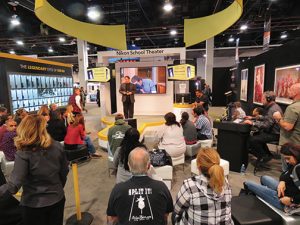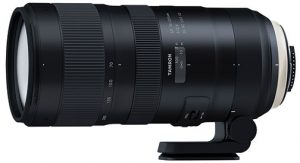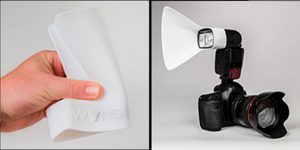
Held February 5–9, 2017, this was the first year the Wedding & Portrait Photographers International Conference & Expo, WPPI 2017, was held at the Las Vegas Convention Center. Reaction to the new, larger venue was generally positive.
One assessment that came up repeatedly from exhibitors was that they liked the idea of all the participating companies being on the same showroom floor. There had been some complaints in the past that companies located in the smaller of the two halls at the MGM Grand Conference Center, where the show had been held in recent years, were somewhat isolated, since all major manufacturers were in the main hall. This time around, however, all the companies were grouped in two adjoining exhibit halls, which exhibitors supported.
 While final participation numbers weren’t available by press time, it was projected that the number of exhibiting companies, the number of participants for the classes and programs, and the number of overall showgoers would be up from last year.
While final participation numbers weren’t available by press time, it was projected that the number of exhibiting companies, the number of participants for the classes and programs, and the number of overall showgoers would be up from last year.
Interestingly though, because of the considerably larger new location, it didn’t seem like the show was as well attended. While there were some choke points when people stopped to listen to one presentation or another, there weren’t throngs clogging the isles as they did at the MGM.
In fact, the whole feeling of the show was different. As one company executive mentioned, not only was the intimacy that was part of the MGM experience somehow lost, so was a certain air of excitement. “It’s a much more low-key show than in the past. It’s missing some of the buzz,” he noted.

However, that wasn’t the case for the first event of the show, the Launch Pad product showcase. Held the afternoon before the trade show opened, it was packed. It was difficult to even get near vendor tables to take a closer look at the products and services on display. Plenty of buzz there.

Another change was that the show was earlier in the year. It came just a month after CES 2017, also held in the LVCC, which most of the major equipment manufacturers attended. Many of the WPPI exhibitors were also at the Professional Photographers of America’s Imaging USA, which was held in San Antonio, Texas, the same week as CES.
Some exhibitors would have liked a little more time between those two shows and WPPI. One camera company executive also noted there weren’t as many product announcements at WPPI because not only was it so close to the other two shows but there was a photokina held last fall, where major product announcements were made.
Photo Capture Products on Display at WPPI 2017
While product introductions were somewhat limited at WPPI, there was a strong selection of products on view that were announced or previewed at photokina, CES and Imaging USA.
Even with the higher resolutions of DSLRs coming onto the market and the quality of the images they capture increasing all the time, for many high-end commercial photographers medium-format digital cameras are still the best choice. And there were several medium-format cameras demoed at the show.
Mirrorless Medium Format
Fujifilm showed its GFX 50S mirrorless, medium-format camera, which is designed around a 51.4 megapixel CMOS sensor and utilizes the company’s advanced X Processor Pro image processor. The lightweight, compact camera is weather resistant and dustproof, making it ideal for use in harsh shooting environments. And it supports tethered shooting.
A number of new GF lenses will also be released during 2017, including the standard lens paired with the GFX 50S—the GF63mm f/2.8 R WR lens. The camera is priced at $6,500 body alone and $8,000 with the kit lens.
The PhaseOne XF 100MP and the 100 megapixel Hasselblad H6D-100c medium-format cameras were also on display.

Low-Light Performers: DSLRs
Low-light shooting capabilities through higher ISO settings are increasing all the time, even for midrange DSLRs. Ricoh showed its Pentax K-1. It is the company’s first full-frame DSLR, and it has an ISO range of 100 all the way up to 204,800. That’s amazing light sensitivity.
Designed around a 36.4MP CMOS sensor, the K-1 utilizes 33 focusing points for highly accurate autofocusing, and it is able to shoot at 4.4 frames per second. It uses a Prime IV processor and 14-bit RAW image file support. It also incorporates the newly developed SRII shake reduction system that corrects for camera shake on five axes and provides up to five shutter steps of image stabilization.
Furthermore, the K-1 has a capability not found in competing DSLRs: it can track astronomical objects. Combining the K-1’s SRII mechanism with its GPS capabilities, the camera’s astrotracer feature makes it possible to track and photograph stars, as someone would with a tracking telescope. The latitude obtained by the GPS and camera position are used to follow the movement of celestial objects, capturing them as points of light rather than trails that arch across the night sky, even during long exposures. The Pentax K-1 has a suggested retail price of $1,950.
Low-Light Performers: Lenses
Another piece of equipment unveiled at the show that makes it easier to shoot in low light is Tamron’s SP70–200mm f/2.8 Di VC USD G2 telephoto lens. For $1,300, it has a lot going for it. A rugged lens with moisture-proof and dust-resistant construction, it has a fast-focusing ultrasonic drive ring-type motor. It also features a shortened minimum object distance of just under a meter (37.4 inches). In addition, XLD (eXtra-low dispersion) glass as well as eBAND coating reduce chromatic aberrations, ghosting and flare.

One of its key features is VC (vibration compensation) of up to five stops. It has three separate stabilization modes, including one exclusively for panning. Such high image stabilization makes it possible to come up with sharp images even in difficult lighting. Available with Nikon or Canon mounts, the SP70–200 can be paired with two teleconverters Tamron also released. Both the 1.4x and a 2.0x converters were designed to specifically match the optics of the new lens.
Photo Output Products & Services at WPPI 2017
Being a wedding and portrait photography show, there were scores of companies with their latest incarnations of wedding albums, photo books and display boxes. There were also several companies providing options to bring the wedding album/photo book production process in-house.
Unibind, the company that started out producing desktop thermal bookbinding units, showed a large stand-alone piece of equipment. They call the photo book binding system the Condor Plus. It’s designed to produce lay-flat, oversized photo books of up to 20×20 inches. But it’s not an automated process; individual pages and the final books have to be assembled manually.
 Still, it’s a relatively simple process of creasing, aligning and pressing. The equipment ensures that everything lines up correctly and all the components fit together. According to Unibind, it takes about four minutes to assemble a 30-page photo book block. Add another 20 minutes of pneumatic press time to make it permanent. (In the demonstration, it took about a minute and a half to two minutes to put one page set together.) The Condor has a price of $5,870.
Still, it’s a relatively simple process of creasing, aligning and pressing. The equipment ensures that everything lines up correctly and all the components fit together. According to Unibind, it takes about four minutes to assemble a 30-page photo book block. Add another 20 minutes of pneumatic press time to make it permanent. (In the demonstration, it took about a minute and a half to two minutes to put one page set together.) The Condor has a price of $5,870.
Film Reemerging
There was a reemerging interest in film and chemical processing at the show. Film has never really gone away, but there hadn’t been much interest in it at recent professional photo trade shows. There was this time around.
A Kodak Alaris reps said he’d seen more interest in film this year than in a very long time. To stoke that interest, Kodak was providing free samples of several of its new 35mm and medium-format films. These include Portra 400 120 film. Another indication of the increased interest in film, the company announced the reintroduction of Ektachrome 100 35mm film. Ektachrome 100 was out of production for about four years.

On the darkroom/development side, companies like Richard Photo Lab were pushing film processing, chemical printing and image scanning as part of their services.
3D Production
One company’s products stood out not so much for what they are but how they are produced. 3D Flex Flash produces light diffusers and modifiers with 3D printers. Its most popular product is the Wyng, a bounce diffuser designed for use with auxiliary on-camera flash units. A small 3D printer sitting on 3D Flex Flash’s booth counter was churning out new Wyngs on demand.

Going forward, a segment of photography products will be produced by smaller companies utilizing 3D printing. That technology is going to become more important for product development. 3D printing makes it possible for smaller companies to get involved in producing products they otherwise would never have the opportunity to develop because of the prohibitive initial tool-and-dye setup costs.
Not too long ago, 3D production was primarily limited to plastic products. But there are new 3D technologies that utilize a metallic powder to print. This development makes it possible to even produce metal products. That opens up 3D printing to a whole new category of products.
Education a Draw
While the WPPI Expo and the exhibited products drew a lot of attention, what really prompted many showgoers to come were the educational opportunities. As in the past, the ongoing exhibit hall presentations by major camera manufacturers were very well attended. Canon, Nikon, Sony, Fujifilm and various other companies hosted photographers who gave how-to sessions and product demonstrations to packed crowds.
A number of attendees said they were drawn to WPPI 2017 specifically for the educational platform—the very informative structured classes, the hands-on walking tours and the more informal exhibit hall presentations. wppionline.com





